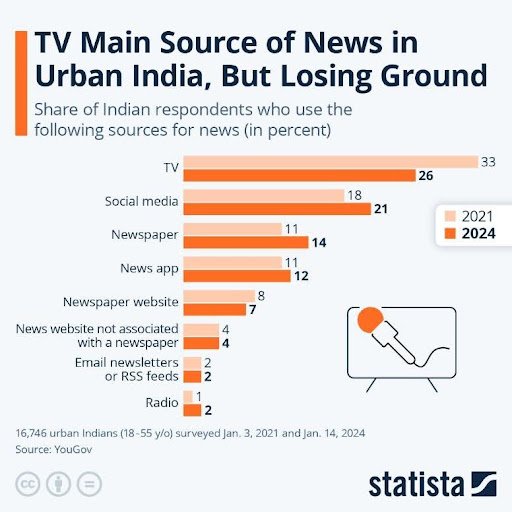
One thing that everyone will admit is that noodles take more than two minutes to cook, but YouTube has cracked the code to serve news in less than one minute, in an interesting manner. Instagram introduced ‘Reels’; hence, YouTube introduced ‘Shorts’. A medium through which attention-deficient Gen-Z can feast upon diverse content, but especially news, within no time. Because of the traditional prime times, ‘10 minute mein 10 badi khabarein’, print media, and “The nation wants to know” have failed to create that magic with the new age who want to listen to the news but not in the traditional manner. (and also wants the news to end within 5-10 minutes).
It is also quite unfair to say that only young people watch the news on YouTube. Nowadays, people of all age groups use the internet for various purposes and to consume news as well. News isn’t just about repeating the same lines again and again to get your point across the heads of the naïve creatures who stare at the TV screen for hours, bobbing their heads at every sentence spoken by the news anchor, retelling news in a ‘Dharma Productions’ performance. However, it now seems that people have grown tired of the same script that is used mostly on all TV news channels.
Lack of diversity and falling credibility
Content consumption in India is currently at an all-time high. We are connected heavily with the internet and social media. No wonder X (formerly known as Twitter) has become one of the major news update apps for many people. A report by the Times of India said that around 70% of Indians rely on online media for news, mainly X. Along with it, YouTube becomes the 2nd most browsed platform to get news updates. This is because YouTube provides a chance for every other person walking down the street to create content. There isn’t much of a restriction there.

The traditional news channels are imprisoned by the venomous chains of high TRP, which forces them to telecast the ‘Masaledaar’ news format, making authentic journalism as well as diversity get hidden in the trenches. Real problems are caged, and propaganda is being instilled in the heads of people. However, with the sudden blow-up of YouTube-produced news content, people are starting to better understand these tactics and get a window to look at various things through a more democratic lens.

YouTube: An arthouse for independent voices
YouTube serves as a platform for creators and consumers and gives a fair chance for people belonging to all walks of life. Given the situation of the current traditional news channels, which are blamed for being heavily appeasing to the government and its ideology, this has led to a great fall in their credibility. Even the older citizens who have grown up watching these channels are slowly shifting their gears to YouTube and WhatsApp.
YouTube also does away with the need for government licenses and approvals, which the TV news ‘Sitcoms’ have not been able to escape. This gives a voice to the otherwise voiceless or ignored segments of society. Lately, it has been noticed that there are also channels on YouTube catering mainly to the North-eastern and Southern regions, people who were mainly ignored or paid less attention to by the mainstream media.
In the uncertain times that we live in, such unbiased and diverse content has helped most of us to look beyond the ideologies and political party appeasement. It has also shaped our thinking positively as well as negatively (in a way). But more than that, YouTube has served as a platform for voices of dissent to be sung fearlessly. Belted out in the most creative yet raw aspects.
But many channels have been blocked on YouTube or taken off due to governmental and fundamentalist pressure. Though a space for open dialogue and free speech, it yet couldn’t escape the restrictions.

Fostering the culture of- Let’s Connect
Another point where YouTube struck gold was firstly investing heavily in independent news sources on its platform. Encouraging the creators and supporting them helped YouTube as well.
YouTube videos come with a comment section. This small yet important addition does a lot of good. It makes content a two-way street where people walk by, stay quiet, or chat randomly with a passerby.
In a way, this is a good psychological trick because when people get the chance to share their opinions, they feel validated, and so their engagement frequency also increases. It helps the news creator to understand their audience better and know about their leanings and their demands.
This is exactly why the traditional media have fallen flat on their faces. The traditional media are restricted to several things, and the typical monotonous approach towards journalism has reflected well on the TRP ratings; hence, their audience is very targeted. Unlike remote or online journalism, traditional journalism depends quite a lot on the infrastructure, which makes it difficult for them to cause a significant tectonic shift immediately.

Conclusion
While YouTube is on the rise, not just in India but in other parts of the world as well, it is important to see the challenges that will come forth. With a bombardment of information and content, it will be difficult to distinguish right from wrong. False news travels faster than authentic news. Though the Gen-Z and millennial crowd is heavily crowding YouTube, it is also not supposed to be forgotten that TV news and print media are still a primary source for News dissemination. Hence, this is like a wake-up call to all TV News to upgrade, present with authenticity, and avoid being petty eyeball chasers.
Written by- Mokshi Gala
Edited by- Aditi Bhuinyan
The post Rise of YouTube as a Replacement for Traditional News Channels appeared first on The Economic Transcript.


